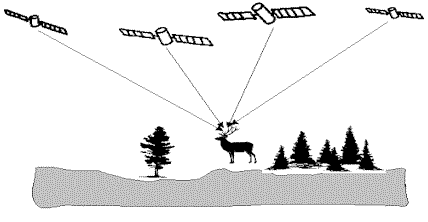Several external sources introduce errors into a GPS position (or other satellite navigation) estimated by a GPS receiver. One important factor in determining positional accuracy is the constellation, or geometry, of the group of satellites from which signals are being received. An indicator of the quality of the geometry of the satellite constellation is the Dilution of Precision or DOP. DOP only depends on the position of the satellites: how many satellites you can see, how high they are in the sky, and the bearing towards them. This is often refered to as the geometry.
The computed position can vary depending on which satellites are used for the measurement. Different satellite geometries can magnify or lessen the position error. A greater angle between the satellites lowers the DOP, and provides a better measurement (Figure 1). A higher DOP indicates poor satellite geometry (Figure 2), and an inferior measurement cofiguration, or in other words: the lower the value the greater the confidence in the solution.
Fig. 1: Example of Good Dilution of Precison
Fig. 2: Example of poor Dilution of Precison
Dilution of Precison components
DOP is often divided up into components. These componets are used because the accuracy of the GPS system varies. The satellites move, so the geometry varies with time, but it is very predictable.
GDOP is computed from the geometric relationships between the receiver position and the positions of the satellites the receiver is using for navigation. GDOP Components are:
- PDOP = Position Dilution of Precision (3-D), sometimes the Spherical DOP
- HDOP = Horizontal DOP (Latitude, Longitude)
- VDOP = Vertical Dilution of Precision (Height)
- TDOP = Time DOP (Time)
While each of these GDOP terms can be individually computed, they are formed from covariances and so are not independent of each other. A high TDOP (time dilution of precision), for example, will cause receiver clock errors which will eventually result in increased position errors.
Good GDOP, a small value representing a large unit-vector-volume, results when angles from receiver to satellites are different. Wheras poor GDOP, a large value representing a small unit vector-volume, results when angles from receiver to the set of SVs used are similar.
Clustered satellites give poor GDOP values.
A rule is: The higher the DOP, the weaker the geometry.
Literature


